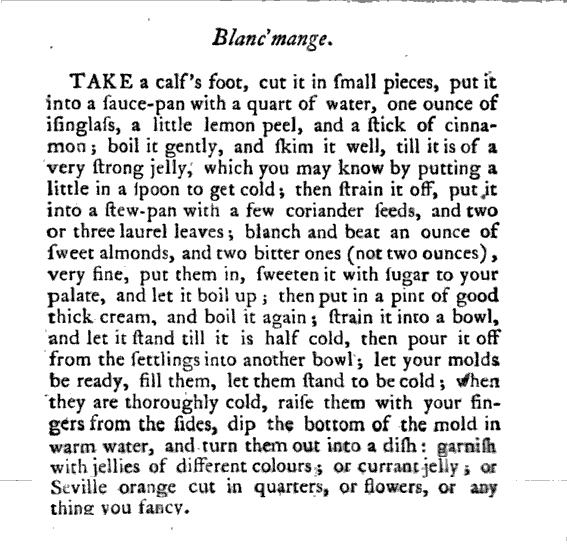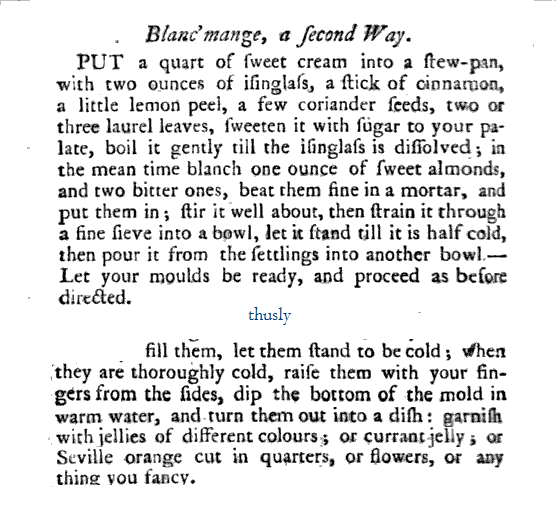As in “shaking like a”. Heyer made this phrase a part of my Regency vocabulary, but in my early days as a reader I really had no idea what a blanc’mange was (let alone that it was pronounced “bla-manzh”). When I looked it up (cause I’m that kind of reader) the description made it sound something like a Jello®-mold from my childhood, and that was good enough for me. I could picture it. When I look at period sources I find descriptions such as: “its face . . . quivered, without ceasing, in a very alarming manner, being, it seems, of a paralytic sensibility like blanc-mange” and “He shook, moreover, like a plate of blanc-mange”.
The English Art of Cookery (1788) contains multiple recipes for blanc’mange. The first begins “Take a calf’s foot, cut it into small pieces, put it into a sauce-pan with a quart of water . . . boil it gently, and skim it well, till it is of a very strong jelly.” Making my own gelatin is going a little too far even for me. The other two recipes begin with “isinglass”. This is a fish-based collagen. Per Wikipedia: “Prior to the inexpensive production of gelatin and other competitive products, isinglass was used in confectionery and desserts such as fruit jelly and blancmange.” I opted to use commercial gelatin, as it aligns closely with the first recipe’s requirements and is easy to obtain. Someday I’ll order isinglass…
The next big challenge was to decide what to do about the fact that all the recipes call for bitter almonds. Bitter almonds are poisonous (they can yield cyanide) and aren’t available in the United States. My options were to use almond extract or apricot seeds. Neither is perfect, but I went for the extract, as that should give the true flavor (almond extract being made from bitter almonds).
Speaking of flavor, the fact that the recipes all call for two or three laurel (bay) leaves seems a bit odd to me, but I went with it (many of the cake recipes call for them too). And then there are the suggestions for how to color the blanc’mange: “When you want to colour your Blanc’mange green . . . put in a little spinach juice . . . If you wish to have it red, bruise a little cochineal and put in; if yellow, a little saffron; if violet colour, a little syrup of violets”. I opted to make a yellow one, mostly because I have a large stash of saffron from my trip to Morocco.
Most modern recipes for blancmange look NOTHING like the period ones. They tend to call for milk thickened with cornstarch. But I did manage to find one that starts with gelatin (from The British Shoppe) and I used it as a starting place.
My recipe
2 envelopes unflavored gelatin
2 cups half-and-half, divided
1 1/3 cups sliced almonds
1/2 cup sugar
1/4 teaspoon almond extract
1 stick cinnamon
zest of ½ lemon
½ tsp coriander seeds
2 bay leaves
Pinch of saffron (optional)
Place 1 c. of the half-and-half and almonds in a blender, and process until smooth. Strain through a sieve into a medium saucepan; discard solids. Stir in sugar, spices, zest and extract and bring to a boil, turn down to a simmer and stir constantly. Heat the other cup of half-and-half and stir in the gelatin. Add the gelatin mixture, stirring until gelatin dissolves; remove from heat. Place your mould or bowl in an ice-filled bowl. Strain into the mould to remove the spices and let it sit until it cools. Place the mould/bowl in the refrigerator until set (4 hours or over night).
The result? It’s actually good! It’s a milky-sweet-almond base slightly odd undertones but everyone liked it. Many of us thought it would be better with fruit or a fruit sauce. It has a sort of dry texture (it’s vaguely cheese-like, sort of like panna cotta, which makes sense once you look at panna cotta recipes) cries out for a fruity sauce. I’ve made it pretty regularly for holiday dessert, and it’s always well-received (especially when topped with a tart fruit compote).


